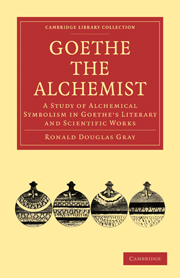IV - The Metamorphosis of Plants
Published online by Cambridge University Press: 10 November 2010
Summary
By the spring of 1787 the botanical work was beginning to take definite shape: it had crystallized into the concept of the ‘Urpflanze’, the primal plant, which was to represent in itself the whole nature of the vegetable kingdom. At the same time, Goethe had lost some of the confident tone which marks his enthusiastic outbursts to Frau von Stein in the previous year. He swings now from the delight in discovery to a cheerful recognition of the extensive labour which he still has before him–and then back again to ecstasy as he finds his theories confirmed. In the same way also he seems to vacillate in his conception of the Urpflanze. On the one hand he appears to regard it as a really existing plant, of which it is possible to find a living example. As he had told Frau von Stein, it was ‘no dream or fancy’. Amid the wealth of flora in Sicily he writes: ‘Faced with so many new and renewed forms, my old whim occurred to me again, that perhaps in all this host I might find the Urpflanze. For there must be one.’ This appears to make it perfectly clear that the Urpflanze was itself one among many other plants. But the words immediately following these give rise to doubt: there must be some such plant, Goethe goes on, for ‘otherwise, how should I know that this or that form is a plant, if they were not all fashioned after one pattern?’
- Type
- Chapter
- Information
- Goethe the AlchemistA Study of Alchemical Symbolism in Goethe’s Literary and Scientific Works, pp. 71 - 100Publisher: Cambridge University PressPrint publication year: 2010First published in: 1952



